As Halloween approaches, Cat Rock looks into puppetry’s relationship with horror. With thoughts from Aya Nakamura, Kathleen Yore, Mike Oleon, and the Puppet Place residents. Featuring a special interview with Sarah Fornace from Manual Cinema about their recent shadow puppetry creation for the 2021 film “Candyman”. Cat explores why and how puppets have been used to unsettle and terrify audiences over the years.
“Puppetry as an art form provides a powerful feeling of escapism and is especially good at tapping into our subconscious fears; bringing to the surface hidden imagery and diving deep into otherworldly places. Strange objects or handmade figures that appear to live, to breathe, and to think in front of our very eyes are like magic, interpreted uniquely by each viewer. What a liberating experience! Even when we present something horrid the audience are still thankful for the journey, still amazed at how a bit of papier-mâché and fabric had them transfixed!” (Kathleen Yore – Odd Doll)

Pupaphobia, the fear of puppets, settling in next to the more common fears of Coulrophobia (fear of Clowns) and Pediophobia (the fear of dolls), is an extreme version of a common human reaction to puppets, one of trepidation, caution and disconcerntainty. A reaction that is still used in horror media as a tool to incite terror and fright in many an audience.
From the horror trope of the evil living doll to the use of puppetry in the creations of monsters, aliens, and creatures, puppets and horror go hand in hand. So it begs the question, are puppets really scary? And if so, why?
The idea of an evil living puppet or doll is so common in media that it could have its own subgenera. Demonic puppets and dolls have appeared in films as early as 1945 (and as creepy symbols even earlier) with Hugo the ventriloquist dummies appearance in “The Dead of Night”. Other films and series include Magic, Dolls, Childs Play (featuring the murderous Chucky), the Puppet Master series, Annabel, The Boy, and let’s not forget films that use puppets to enhance their creep factor such as the Saw franchise’s mascot Jigsaw. Even Pixar used spooky ventriloquist dummies in their most recent Toy Story film. It is a wonder that children’s toy shops even sell puppets and human figures any more!
The first time I remember being exposed to the evil puppet concept was with the Goosebumps children’s horror book series, and their title “Night of the Living Dummy” back in 1993. The book went on to have two sequels and is one of the most popular and well known books in the Goosebumps series. Targeting adults and children, and exploring all media, from film, tv, books, and theatre, you cannot escape the connection between horror and puppetry.
One theory is that puppetry taps into the robotics and computer graphics principle of the “Uncanny Valley”. People have been studying this concept to find out why there is a fine line between a humanoid construction being either likeable or repelling. We connect with human-like creations, in fact we are drawn to them, but only to a certain point, when an invisible line is crossed and that thing becomes too human, like we become disconcerted by its presence. Does this switch in perception evoke a sense of trepidation because it seems as if the figure is trying to trick us, making us believe it is a person when in fact it is a construct? Maybe there is something about not seeing true life behind those realistic puppet eyes that just makes us squirm.
“Assume we could make a robot more and more similar to a human in form, would our affinity to this robot steadily increase as realism increased or would there be dips in the relationship between affinity and realism.” (Masahiro Mori, 1970) Ref 1
Puppetry legend Janni Younge once said, “The puppet is a dead thing that’s brought to life.” (Ref 3). Breathing life into your puppet is one of the core fundamentals of puppetry, the magic of manipulation is that you can look at an inanimate object and see a living thing. You connect with it, you believe it, and you feel it. Depending on the context this can be a wonderfully magic moment or one that can fill you with a sense of wrongness. Puppets are things that are not alive, but act as if they are, if that is not the basis for horror then I don’t know what is.
Aya Nakamura is Associate Artist of Rouge28 Theatre and has performed in the Japanese Ghost Story show KWAIDAN, she says, “People tend to find puppets scary when puppets are figurative. I believe it’s because it imitates living beings and the viewers can perceive it as being alive yet also, they know that it is not real. They cannot tell exactly how or why it becomes scary. We, as humans, find things that we do not know scary.”
Can you say that puppets are the living dead?
Puppet Place resident artist Ben Mars says, “They behave as if conscious, but that consciousness is particularly other.”
Perhaps, it is the relationship between audience, puppet, and puppeteer that can trigger us. It is so easy for an audience to imprint on a puppet. That’s why they are such amazing things to use in performance. But if we are using those puppets in a malicious and cruel way, or they themselves are being treated horribly, do we as an audience feel it more because we see ourselves in the puppets? Is our ability to experience these scary situations ourselves through the lens of a puppet what makes them a great horror tool? There is something to be said there also about this lens providing a certain amount of protection to the viewer; we can engage fully with what is happening but from the safety of our own seat.
In Chicago, there is a new theatrical experience taking place created by Rough House Theatre. “The House of the Exquisite Corpse”, a horror peep-show, puppet-theatre anthology, invites the audience to peer through keyholes, cracks, and hidden doors to discover surreal worlds that will terrify and amaze…
Mike Oleon from Rough House had this to say, “Puppets beg to be animated with vital life force, and fear is one of our most fundamental emotions. Fill a puppet with something that provokes that fear and you will find they are perfect vessels through which audiences can experience the most profound terror and emerge unscathed. That is thrilling.”
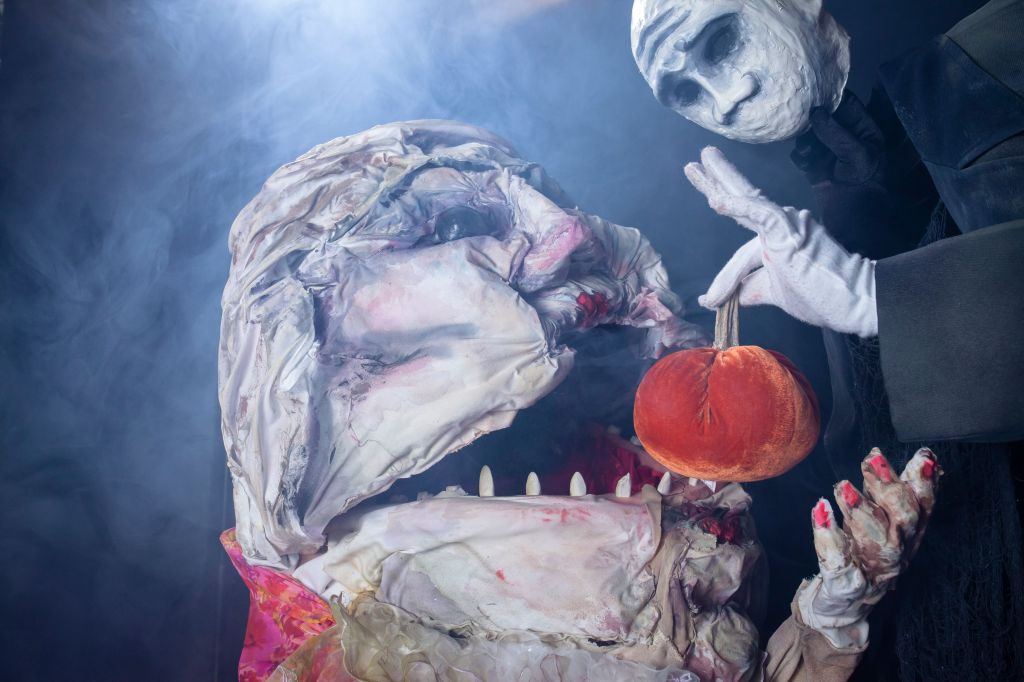
Another very practical reason why puppets work so well in horror is that puppet design is only limited by a creator’s imagination (and budget!). Bodies can be elongated, features distorted, and finishings worn and damaged. Puppets can be made to look like something straight out of a nightmare.
As Chris Pirie from Green Ginger says, “It’s all about eye position. Too close together – uncanny. Too far apart – uncanny. Just right – really f**king freaky!”
We can bend puppets to physically resemble the thing that terrifies us.
Aya Nakamura adds, “Puppets are good at taking the shape of the artists’ imaginations and visions. Puppet makers can create the creature as they wish. And their advantages are different from human actors. Puppets can fly and transform, they can have many tentacles or less limbs than humans. These help to make creatures and make them less ordinary humans or animals.”
From making slight unsettling changes to human figures to large leaps with tentacles, blood red eyes, and gnashing teeth, we can make puppets look like anything, and if we choose that anything can be really scary.

Another notion is that puppets, dolls, and toys are closely linked to our childhood. At this early stage of life we are vulnerable, small inquisitive creatures, unknowing of the dangers of the real world that we come to learn as we grow up. The phrase ‘the past comes back to haunt us’ comes to mind, as a lot of our grown up fears come from our childhood experiences. Older siblings or bullies stealing and mutilating our favourite toys, clutching a doll for comfort whilst grownups argue in the other room, or staring at the freaky frog teddy in the dead of night just waiting for it to blink. By using puppets as a source of ill intent and evil, are we tapping into that childhood sense of vulnerability, uprooting those experiences that have come to mould us as adults?
It is also a time where our imaginations run wild and anything seems possible. Children learn and experience the world through play. By using these playful tools to create a sense of unease, are we tapping back into our powerful childhood imaginations, which now, as adults, are skewed to picture the dark as well as the light? Is that why an old, abandoned child’s playroom and warped children’s music can fill a person with dread?
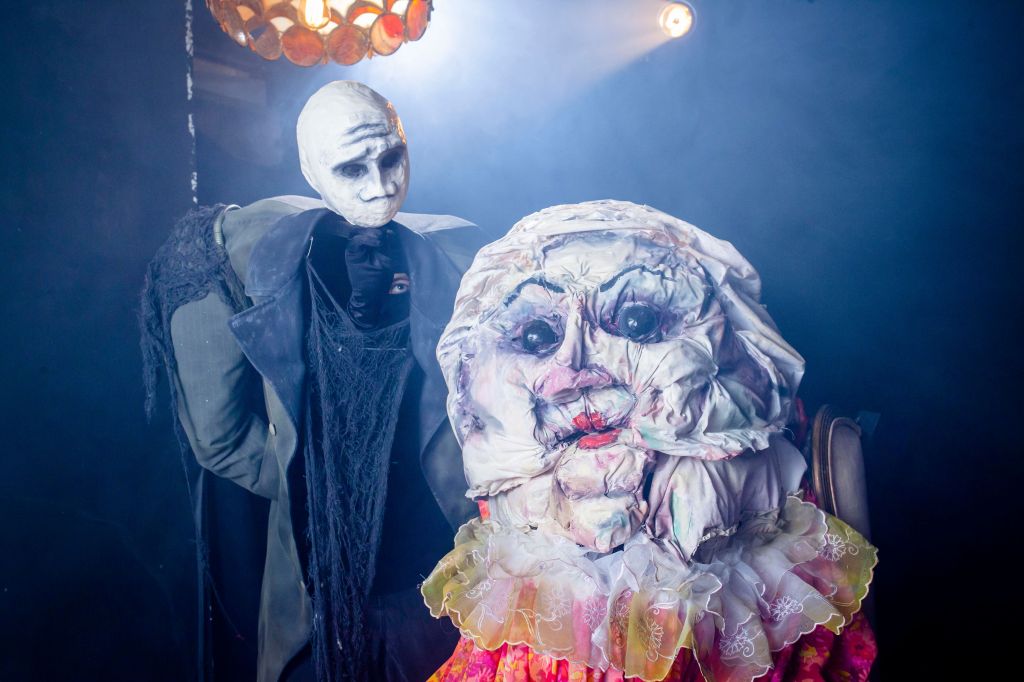
As a puppeteer and puppet maker, I spend my life surrounded by weird, wonderful, and sometimes creepy puppets. I have never felt unsettled in their presence (apart from that one time I accidentally stumbled on a hunched over lifesize old man puppet in a pitch black Puppet Place, then I did jump), I feel in control of my tools and at my place of work. Is that it then? Is the idea of control a key factor? Puppets are designed to be controlled, manipulated, but often in horror there is a dramatic control shift, the puppet comes to life or is possessed for example. Is the fear of losing control physically represented by a puppet? In Nightmare on Elm Street 3 there is a Scene where one of the characters is forced to be a grotesque human puppet, manipulated by Freddy Krueger. In this example, this person could not be less in control. Perhaps, the lack of control of something that is meant to be controlled is what makes the fear of puppets a reality.
Max Dorey, from Puppet Place, makes an interesting comparison between puppets and classic novels, “Pinicio, perhaps the atypical and earliest puppet gone rogue, was written in 1883… Frankenstein, also about a creator losing control of their creation was written in 1818. The idea of a living doll I would say is scary because it is a total removal of power that then turns the aspect of control on its head.”
Interesting, that two very different stories have so many similarities when you start to think about them. The idea of control, taking it, losing it, wanting it, being tricked by someone who has it… Do we relate to this sense of powerlessness and futility when we see such a clear representation through a living doll? Do we relate to the manipulator, the controlled and the power struggle between them simultaneously?
Eloise Dunwell, from Puppet Place, adds, “Maybe what’s also strange is that performance can only come from what us humans can think up, so will it always be a representation of the psyche?”
Puppets need to be controlled by something, but by what? Perhaps the notion of a human manipulator scares us because we know how dark humanity can be. Especially when the identity of someone is removed. You need not look far on social media to see how people’s behaviour changes when they have the shield of anonymity. Does a puppet give that kind of shield if used by someone with dark intent, and is that what makes people distrust a puppet in certain instances? The puppet that you see could be so very different from the person hiding behind it.
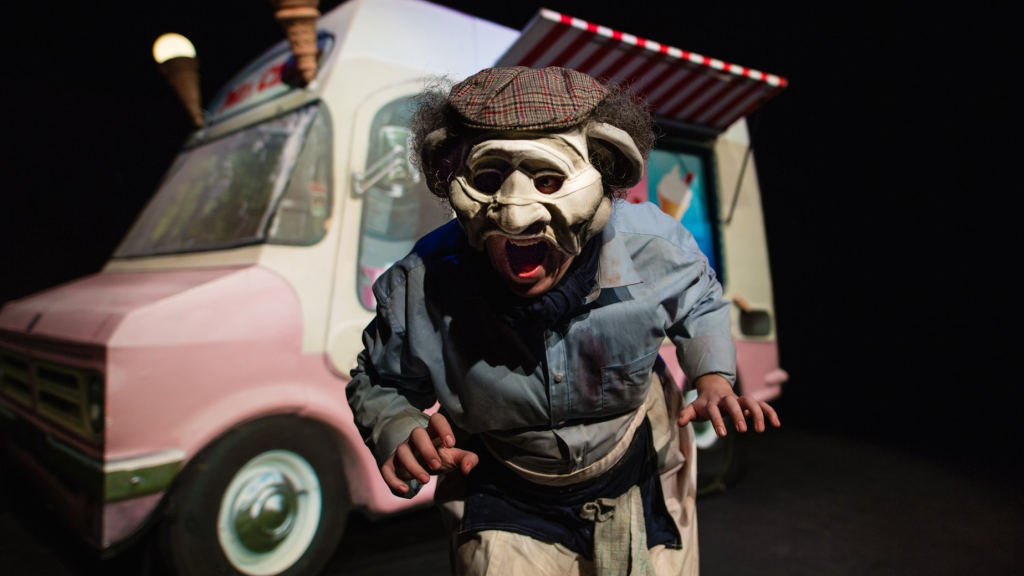
Humans can be scary, yes, but is it only people who can manipulate puppets? Puppets are literally vessels created to be controlled, so it isn’t surprising that puppets have been used in supernatural stories from ghosts to demons, voodoo to witchcraft. Do puppets give us the sense that we have created an unpredictable path between our world and another?
Emma Windsor from White Rabbit Animation says, “The notion of puppets and dolls as magic objects is deep rooted in our collective consciousness, I think. Pre-history, humanity was carving small objects that represented or were thought to capture the gods or supernatural forces, the The Venus of Willendorf figurine springs to mind. So I think this connection between small figurines and the supernatural is hard wired in most human cultures.”
If we grow up with this idea that puppets, dolls, and figures are innately magical, of course then we can use this to our advantage when telling stories of a dark nature.
No matter how you look at it, puppets are able to connect with audiences in a way that can draw out and enhance the fear within us all. So why are we drawn to the macabre and terrifying especially in terms of entertainment? One great example of a puppet horror stage show is Seaside Terror by Odd Doll. Stuffed with fun frights and ice cream chills, Seaside Terror is a celebration of British horror and British holidays of the 1970s.
Kathleen Yore, Artistic Director of Odd Doll, has this to say, “As an art form it provides a powerful feeling of escapism and is especially good at tapping into our subconscious fears; bringing to the surface hidden imagery and diving deep into otherworldly places. Strange objects or handmade figures that appear to live, to breathe, and to think in front of our very eyes are like magic, interpreted uniquely by each viewer. What a liberating experience! Even when we present something horrid the audience are still thankful for the journey, still amazed at how a bit of papier-mâché and fabric had them transfixed!”
Puppetry is an amazing storytelling medium by adding weight and engageability to new stories. When you create puppets you are creating a world with new rules. The characters, props, and set can all be manipulated to create this unique space, even the gravity can be different. You as the creator set your own laws. This merges so well with horror, where the unexpected and the twisting of reality can create unnerving stories. Again, back to the idea that something is familiar but a bit off. The fact that puppets are physical entities also enhances an audience’s connection with them. You feel like you can touch or be touched by them and bring you deeper into the world. This is why puppets and horror work so well on stage and on screen.
Kathleen Yore says, “I believe that great horror and great puppetry is all about well thought out visual imagery. Experimenting with light and dark, what we see and don’t see, like a living comic book, moving from one picture to the next. So it goes without saying that puppetry lends itself perfectly to the telling of a scary story.”
They goes on to say, “Working with puppets provides a license to see how far we can push things; puppets poo, their teeth fall out, or they can die in gruesome ways. Despite being presented with such darkness, audiences often find themselves laughing. Perhaps working with puppets provides a form of distance from the true horror of what we are presenting?”
Puppets allow ‘space’ (see Sarah Fornace interview) for the audience to fill in the gaps. What we imagine can often be more terrifying than what we are shown. You can address the subject head on but in an abstract or slightly removed way, allowing an audience to insert themselves or their ideas into the story. This is why we are seeing more and more puppetry being used in mainstream media.
In 2021, Candyman hit cinemas nationwide bringing with it an eerie shadow puppet film created by Chicago’s Manual Cinema.
Their piece was used in the trailer of the film and is referred to throughout, a powerful yet disconcerting framing device which enhances the tone, atmosphere, and surrealism of the film.
I caught up with Sarah Fornace from Manual Cinema to talk about Candyman.
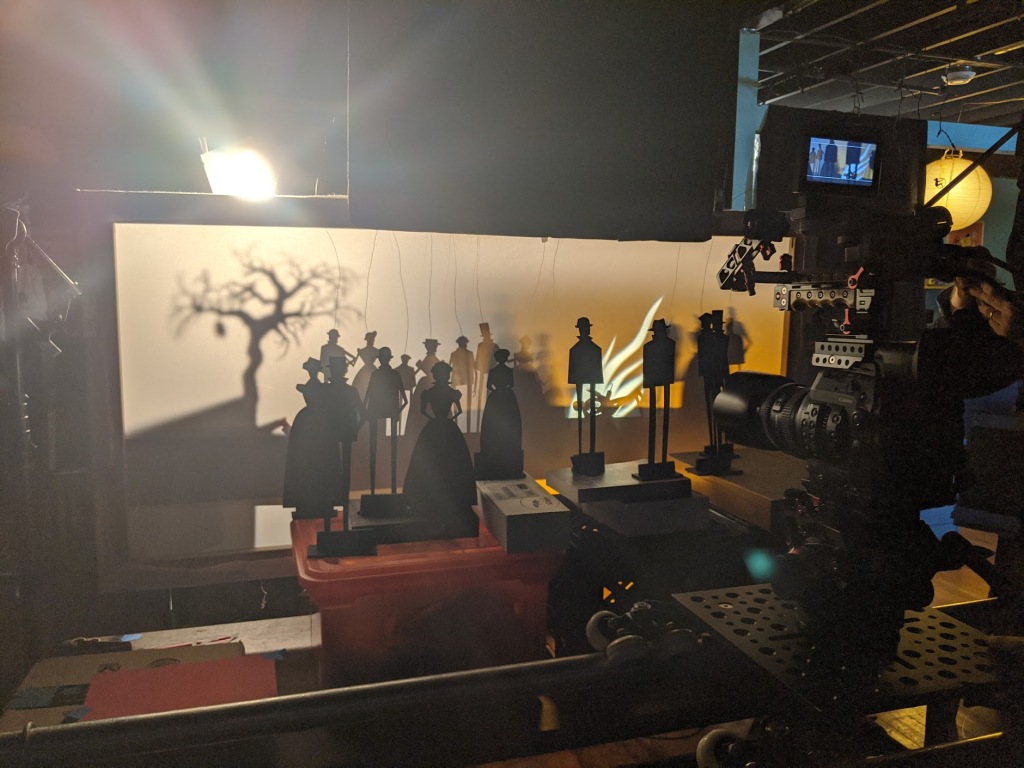
So let’s start with this idea that puppets address horror and violence with a layer of abstraction that gives the audience space to connect with the material. Here is the part of our interview where we start touching on that subject…
The shadow puppetry in Candyman is beautifully creepy, working well with the live action world of the main film to enhance key points, emotions and atmosphere. I asked Sarah why shadow puppetry was the right choice for this production…
As we talked we dove deeper into why puppetry works so well to tell horror stories and why they chose puppets over other performance styles specifically for the Candyman film…
I love that sentence, “…everything a puppet does is inherently meaningful.”
When we use puppetry to tell a story, as a whole production or as a selected section, we are highlighting the importance of that story. A bit like Shakespeare using iambic pentameter to capture attention at key theatrical moments, puppetry adds weight and importance to a story by its sheer presence. When used within a horror context we are highlighting, without words, the weight of these moments, drawing the audience deeper into the narrative where what they see will hold greater impact.
As Kathleen puts it, “Certain horror films have put the fear of clowns, masks, and puppets into some of our audience, but when a puppetry performance begins, the overwhelming sense of craftsmanship and perfect manipulation which portrays every thought, every breath, every moment of the story, quickly eradicates any doubts about how magnificent this art form is. But of course, being aware of this underlying fear is something we as artists can very easily use to our advantage if we wanted to!”
No matter how you look at it, puppets have the ability to target the fears within us all. From the ideas of control, power and lack thereof, to the physical designs, universal appeal and their reality warping capabilities; to connections with our childhood selves and the idea that the unknown is a thing to fear. Puppets can engage us in pleasant magical ways, but like most things there is always another side to the coin, the more you can connect with something the more power it holds over you. So when used in just the right (or wrong) way, puppetry can tell the most terrifying of stories.
So remember, treat your puppets nicely, just in case, because you never know what puppets get up to when you leave them behind closed doors…
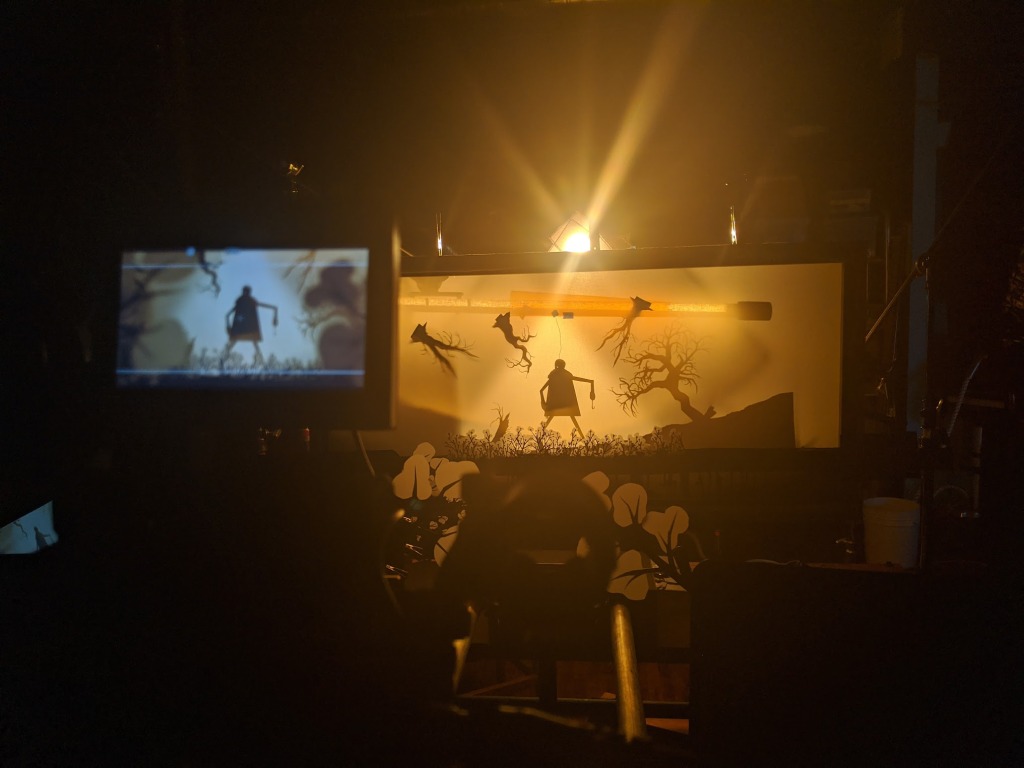
Article by Cat Rock
Thanks to:
Sarah Fornace – Manual Cinema
See the full edited interview here
Kathleen Yore – Artistic Director of Odd Doll
Aya Nakamura – Puppeteer • Puppet Maker • Theatre Maker
Mike Oleon CO-ARTISTIC DIRECTOR Rough House
https://www.roughhousetheater.com/
House of Funny Noises
https://www.houseoffunnynoises.com/
Puppet Place Residents and Associates
Ben Mars
Max Dorey
Eloise Dunwell
Chris Pirie
Emma Windsor
References
Ref 1
In Search of the Uncanny Valley by Frank E Pollick
https://www.psy.gla.ac.uk/~frank/Documents/InSearchUncannyValley.pdf
Ref 2
Uncanny Valley
Rosenthal-von der Pütten, AM et al. Neural Mechanisms for Accepting and Rejecting Artificial Social Partners in the Uncanny Valley. Journal of Neuroscience
https://www.jneurosci.org/content/39/33/6555
Ref 3
Puppetery; Brinning a dead thing to life – Source CNN
https://edition.cnn.com/videos/world/2017/02/08/african-voices-capetown-puppetry-new-a.cnn
